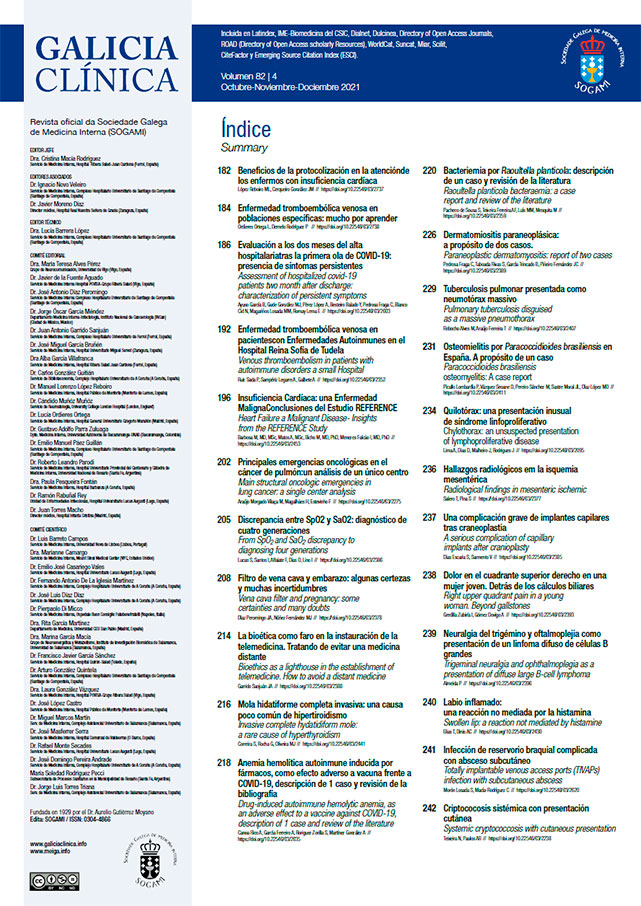Galicia Clínica by Sociedad Gallega de Medicina Interna is licensed under a Creative Commons Reconocimiento-NoComercial-SinObraDerivada 4.0 Internacional License.
Created from galiciaclinica.info.
Similar Articles
- Marta Azevedo Ferreira, Joana Marques, When the virus painted an unusual presentation , Galicia Clínica: Vol. 85 No. 1 (2024): Galicia Clinica - Official Journal of the SOGAMI
- Joana Ribeiro, Lara Adelino, Hepatocellular carcinoma after Fontan procedure: case report , Galicia Clínica: Vol. 85 No. 4 (2024): Galicia Clinica - Official Journal of the SOGAMI
- Marta Araújo Morgado Vilaça, Helena Magalhães, Fernanda Estevinho, Main structural oncologic emergencies in lung cancer: a single center analysis , Galicia Clínica: Vol. 82 No. 4 (2021): Galicia Clinica - Official Journal of the SOGAMI
- Telmo Coelho, João Miranda, Raquel Moura, Paula Ferreira, Autoimmune Haemolytic Anaemia After Covid 19 Infection , Galicia Clínica: Vol. 84 No. 2 (2023): Galicia Clinica - Official Journal of the SOGAMI
- Sérgio Brito, Sérgio Pinho, Massive coral calculus in chronic xanthogranulomatous pyelonephritis , Galicia Clínica: Vol. 82 No. 2 (2021): Galicia Clinica - Official Journal of the SOGAMI
- Adela Lama López, Lung Ultrasound for COVID-19 prognosis a unique experience on elderly patients , Galicia Clínica: Vol. 85 No. 3 (2024): Galicia Clinica - Official Journal of the SOGAMI
- Cátia Ribeiro Santos, Cláudia Antunes, Cátia Faria, João Crespo Santos, Type A Aortic Dissection Presented As A Stroke Mimicker , Galicia Clínica: Vol. 82 No. 1 (2021): Galicia Clinica - Official Journal of the SOGAMI
- Galicia Clínica, Severe neuropsychiatric symptoms due to vitamin b12 deficiency: a case of pernicious anemia or metformin use? , Galicia Clínica: Vol. 76 No. 4 (2015): Galicia Clinica - Official Journal of the SOGAMI
- Roi Suárez-Gil, Emilio Casariego-Vales, Telemedicine and Clinical Practice , Galicia Clínica: Vol. 84 No. 1 (2023): Galicia Clinica - Official Journal of the SOGAMI
- Carolina Ourique, Filipa Gomes, Paraneoplastic Acrokeratosis (Bazex Syndrome) associated with lung adenocarcinoma , Galicia Clínica: Vol. 78 No. 3 (2017): Galicia Clinica - Official Journal of the SOGAMI
You may also start an advanced similarity search for this article.
Most read articles by the same author(s)
- Yoana Besteiro-Balado, Ana Rodríguez-Álvarez, Roi Suárez-Gil, Juan Carlos Piñeiro-Fernández, When two zebras meet: hypermobile Ehlers-Danlos syndrome and superior mesenteric artery syndrome. , Galicia Clínica: Vol. 85 No. 1 (2024): Galicia Clinica - Official Journal of the SOGAMI


